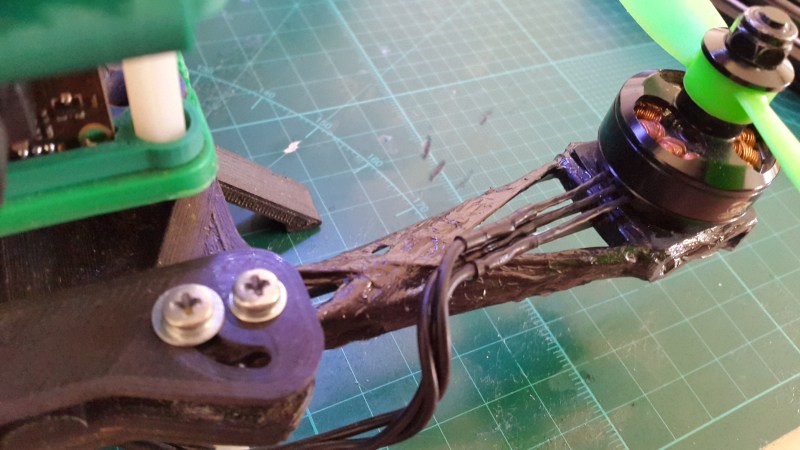[prubeš] shows that parts printed with carbon fiber filament are as strong, or at least as stiff, as you’d expect. He then shows that his method for producing carbon fiber parts with a mixture of traditional lay-up and 3D printing is even stronger and lighter.
[prubeš] appears to be into the OpenR/C project and quadcopters. These things require light and strong parts for maximum performance. He managed to get strength with carbon fiber fill filament, but the parts weren’t light enough. Then he saw [RichMac]’s work on Thingiverse. [RichMac] designed parts with pre-planned grooves in which he ran regular carbon fiber tow with epoxy. This produced some incredibly strong parts. There’s a section in his example video, viewable after the break, where he tests a T joint. Even though the plastic starts to fail underneath the carbon fiber, the joint is still strong enough that the aluminum tube inside of it fails first.
[prubeš] innovation on [RichMac]’s method is to remove as much of the plastic from the method as possible. He designs only the connection points of the part, and then designs a 3D printable frame to hold them in place. After he has those in hand, he winds the tow around the parts in a sometimes predetermined path. The epoxy cures onto the 3D print creating a strong mounting location and the woven carbon fiber provides the strength.
His final parts are stronger than 100% infill carbon fill prints, but weighs 8g instead of 12g. For a quadcopter this kind of saving can add up fast.
















It’s an interesting way of working, but I can’t help but feel that, with the T-joint setup, the 3d-printed part is kind of redundant; I suspect you’d get better, lighter results shaping the end of the pipe a little, drilling a few small holes through, and binding the joint with carbon fiber directly.
eeh why drill at all? just wrap it arround and be done with it.
Yes, I was thinking along the same lines. The plastic failed, and yet the integrity of the joint was maintained. The only reason for the plastic is to keep the carbon fiber in place, right? With that in mind, maybe a much lighter joint could be designed.
The plastic part provides a series of groves in which the reinforcing rests, which allows it to continue to function despite a certain amount of deformation. If you glue or otherwise attach the fiber directly to the tubes then any distortion or motion of the pipe breaks the bond and allows the fiber to shift thus allowing more shifting of the pipe escalating to failure. Also the plastic piece minimizes discreet attachment points, which are stress risers. Finally, the T junction was a demonstration piece, if you look at the object shown in the picture up top you will see that it is basically an open framework with carbon providing most of the structure.
if you plan to use mainly aluminiumtubes, i see the appeal of the provided solution. bonding of epoxy and aluminium, specially such tiny bondingspots, is mostly a point of failure.
there is german drone manufacturer (as in manual labour ;) )who bilds similar carbon fibre structures for his professional-grade UAVs and he does the wrapping “tube to tube” using prefabbed CF tubes. if neccessary tubes get a support structure of thin CF strings (think of a camera boom). those bonds are quite beefy
Which German manufacturer?
forgot his name, met him once on a droneafficiando meetup. will try to fetch u some more info on him.
Epoxy resin has very little elasticity, so provided that you get good wetting on the tube, you could make 3D printed scaffolding to aid installing the tow and then remove most of the scaffolding once the epoxy has cured.
That’s amazing. I’m shocked that a 3D printed part reinforced with so little carbon fiber is that strong.
Well done. Thanks for sharing.
Impressed – yes, shocked – no.
The carbon fiber he’s using is way stronger (at least in tension) then any aluminium alloy or ABS, so it’s not much of a surprise that the thin-walled tube gives in first.
ABS isn’t particularly strong.
I like roboforcerx2000’s build methods, using superglue and fishing line to wrap carbon tubes and hand-cut fiberglass frames. https://www.youtube.com/watch?v=hG3ZsgI4YnI
use 3d printed molds, fiberglass and drop the 3d printed plastic in the joint. This would cut the weight of the joint by 90% with an ultralight fiberglass and probably be stronger.
MarkForged actually make a 3D printer which can produce carbon/fiberglass/kevlar-nylon composite:
https://markforged.com
looks expensive. wrapping techniques will be the cheapest way to get close for the folks at home.
Or Use carbon fiber fillament
https://www.proto-pasta.com/pages/carbon-fiber-pla
the whole idea of thsi approach is to create a joint, stronger and lighter than one made of fibre filaments (the latter lack the advatages of a continous fibre)
What about adding this same fibers while printing? For example lay down few layers of plastic then put one fiber, then some more plastic and another fiber. It is easy to add some G code to pause the print while adding the fiber. It would not have this much effect (since no adhesive is used), but I think it would definitely improve strength of the part.
I think this is what Markforged does.
This is much cheaper and (for certain part types) probably easier.